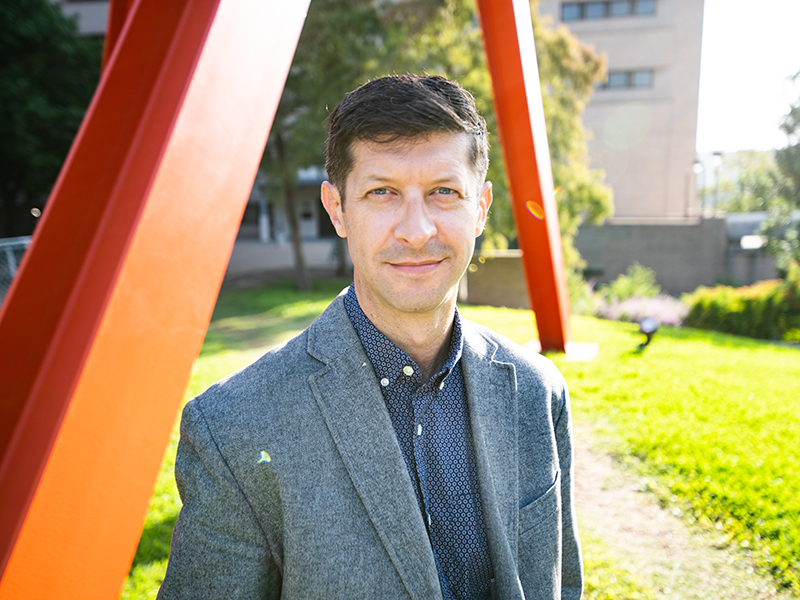Back to Faculty Directory

haberman@utexas.edu
512-471-8317
Office Location: ETC 4.146D
Michael Haberman
Associate Professor
Fluor Centennial Teaching Fellowship in Engineering #1
Department Research Areas
Acoustics
Dr. Haberman is an Associate Professor in the Walker Department of Mechanical Engineering at the University of Texas (UT) at Austin with a joint appointment at the Applied Research Laboratories UT Austin. He received his Ph.D. and Master of Science degrees in Mechanical Engineering from the Georgia Institute of Technology in 2007 and 2001, respectively, and received a Diplôme de Doctorat in Engineering Mechanics from the Université de Lorraine in Metz, France in 2006. His undergraduate work in Mechanical Engineering was done at the University of Idaho, where he received a B.S. in 2000. Dr. Haberman's research interests are centered on elastic and acoustic wave propagation in complex media, acoustic metamaterials, new acoustic transduction materials, ultrasonic nondestructive testing, and vibro-acoustic transducers. His current research focuses on modeling, design, and testing of composite materials, metamaterials, and architected media. His research finds application in technical areas that include the absorption and isolation of acoustical, vibrational, and impulsive energy using negative stiffness and Willis coupling, devices that make use of non-reciprocal acoustic and elastic wave phenomena, and condition monitoring of lithium-ion batteries using ultrasonic methods. He is a Fellow of The Acoustical Society of America and served two terms as the chair of the Technical Committee on Engineering Acoustics from 2018-2024.
Recent publications
- X. Xu, Q. Wu, H. Chen, H. Nassar, Y. Chen, A.N. Norris, M.R. Haberman, G. Huang, “Physical observation of a robust dynamic pumping in acoustic materials,” Physical Review Letters, 125, 253901, (2020). https://doi.org/10.1103/PhysRevLett.125.253901
- A.J. Lawrence, B.M. Goldsberry, S.P. Wallen, M.R. Haberman, “Numerical study of focusing using a single-medium bianisotropic acoustic lens,” Journal of the Acoustical Society of America, 148(4), EL365, (2020). https://doi.org/10.1121/10.0002137
- B.M. Goldsberry, S.P. Wallen, M.R. Haberman, “Non-reciprocal vibrations of finite elastic waveguides with spatiotemporally-modulated material properties,” Physical Review B, 102, 014312, (2020). https://doi.org/10.1103/PhysRevB.102.014312
- Y. Chen, X. Li, G. Hu, M. R. Haberman, G. Huang, “An active mechanical Willis meta-layer with asymmetric polarizabilities,” Nature Communications, 11, 3681, (2020). https://doi.org/10.1038/s41467-020-17529-2
- H. Nassar, B. Yousefzadeh, R. Fleury, M. Ruzzene, A. Alù, C. Daraio, A.N. Norris, G. Huang, M.R. Haberman, “Nonreciprocal acoustic and elastic materials,” Nature Reviews Materials, 5, 667-685 (2020). https://doi.org/10.1038/s41578-020-0206-0
- S.G. Konarski, M.F. Hamilton, M.R. Haberman, “Nonlinear, coupled multiscale dynamics for heterogeneous medium with designed microstructure instabilities,” Physical Review E, 101, 022215 (2020). https://doi.org/10.1103/PhysRevE.101.022215
- R. Fleury, M.R. Haberman, G. Huang, A.N. Norris, “Introduction to the Special Issue on Non-reciprocal and Topological Wave Phenomena in Acoustics,” The Journal of the Acoustical Society of America, 146, pp. 719 – 720, (2019). https://doi.org/10.1121/1.5119133
- B.M. Goldsberry, S.P. Wallen, M.R. Haberman, “Finite element investigation of non-reciprocal wave propagation in mechanically-modulated continuous elastic metamaterials,” The Journal of the Acoustical Society of America, 146, pp. 782 – 788, (2019). https://doi.org/10.1121/1.5115019
- C. Morris, L. Bekker, C.C. Seepersad, M.R. Haberman, “Static and Dynamic Evaluation of a Tunable Acoustic Metamaterial with Constrained Negative Stiffness,” Advanced Engineering Materials, 21, 1900163, (2019). https://doi.org/10.1002/adem.201900163
- S.P. Wallen and M.R. Haberman, “Non-reciprocal wave phenomena in spring-mass chains with effective stiffness modulation induced by geometric nonlinearity,” Physical Review E, 99, 013001, (2019). https://doi.org/10.1103/PhysRevE.99.013001
- M.B. Muhlestein, B.M. Goldsberry, A.N. Norris, M.R. Haberman, “Acoustic scattering from a fluid cylinder with Willis constitutive properties,” Proceedings of the Royal Society of London A, 474, 20180571, (2018). https://doi.org/10.1098/rspa.2018.0571
- S.G. Konarski, M.R. Haberman, M.F. Hamilton, “Frequency-dependent effective medium behavior due to nonlinear microscale inclusions,” Journal of The Acoustical Society of America, 144(5), pp. 3022 – 3035, (2018). https://doi.org/10.1121/1.5078529
- C. Morris, J.M. Cormack, M.F. Hamilton, M.R. Haberman, C.C. Seepersad, “Ultrasonic characterization of the complex Young’s modulus of polymer parts fabricated with microstereolithography,” Rapid Prototyping Journal, 24(7), pp. 1193-1202 (2018). https://doi.org/10.1108/RPJ-01-2018-0011
- C. Morris, L. Bekker, M.R. Haberman, C.C. Seepersad, “Design exploration of reliably manufacturable materials and structures with applications to negative stiffness metamaterials and microstereolithography,” Journal of Mechanical Design, 140(11), 111415, (2018). doi: 10.1115/1.4041251
- D. Debeau, C.C. Seepersad, M.R. Haberman, “Impact Behavior of Negative Stiffness Honeycomb Materials,” Journal of Materials Research, 33(3), pp. 290 – 299, (2018). doi.org/10.1557/jmr.2018.7. Invited Article
- B.M. Goldsberry and M.R. Haberman, “Negative stiffness honeycombs as tunable elastic metamaterials,” Journal of Applied Physics, 123, 091711 (2018). doi.org/10.1063/1.5011400.
- C.F. Sieck, A. Alù, M.R. Haberman, “Origins of Willis coupling and bianisotropy in acoustic metamaterials through source-driven homogenization,” Physical Review B, 96, 104303 (2017). doi. 10.1103/PhysRevB.96.104303.
- H. Nassar, H. Chen, A.N. Norris, M.R. Haberman., G.L. Huang, “Non-reciprocal wave propagation in modulated acoustic metamaterials,” Proceedings of the Royal Society of London A, 473, 20170188 (2017). doi: 10.1098/rspa.2017.0188.
- M.B. Muhlestein, C.F. Sieck, P.S. Wilson, M.R. Haberman, “Experimental evidence of Willis coupling in a one-dimensional effective material element,” Nature Communications, 8, 15625, (2017). doi:10.1038/ncomms15625.
- X. Su, A.N. Norris, C.W. Cushing, M.R. Haberman, P.S. Wilson, “Broadband focusing of underwater sound using a transparent pentamode lens,” The Journal of the Acoustical Society of America, 141(6), pp. 4408–4417, (2017). doi: 10.1121/1.4985195
Selected publications:
- M.B. Muhlestein, C.F. Sieck, P.S. Wilson, M.R. Haberman, “Experimental evidence of Willis coupling in a one-dimensional effective material element,” Nature Communications, 8, 15625, (2017). doi:10.1038/ncomms15625.
- R. Fleury, D.L. Sounas, C.F. Sieck, M.R. Haberman, A. Alù, “Sound isolation and giant nonreciprocity in a compact acoustic circulator,” Science, 343, pp.516-519, (2014). doi: 10.1126/science.1246957
- M.D. Guild, A. Alù, M.R. Haberman, “Cloaking an acoustics sensor using scattering cancellation,” Applied Physics Letters, 105(2), 023510, (2014). doi. 10.1063/1.4890614.
- D.M. Correa, C.C. Seepersad, M.R. Haberman, “Mechanical design of negative stiffness honeycomb materials,” Integrating Materials and Manufacturing Innovation, 4:10, 10 pgs, (2015). doi: 10.1186/s40192-015-0037-9.
- H. Nassar, B. Yousefzadeh, R. Fleury, M. Ruzzene, A. Alù, C. Daraio, A.N. Norris, G. Huang, M.R. Haberman, “Nonreciprocal acoustic and elastic materials,” Nature Reviews Materials, 5, 667-685 (2020). https://doi.org/10.1038/s41578-020-0206-0






